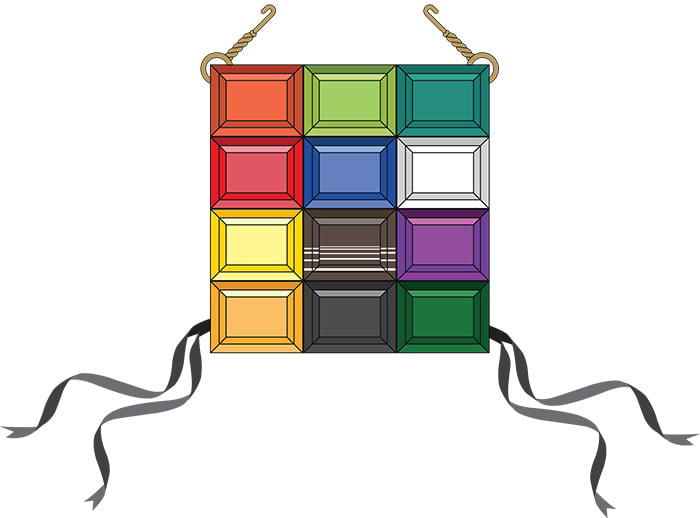Have you ever wondered where the idea of birthstones comes from? It may surprise you that the history of birthstones has its roots all the way back in the Bible. In fact, the King James Version of the Bible contains an astonishing 1,704 references to gemstones. The most detailed description of all can be found in the Book of Exodus, a text probably based on ancient oral tradition and written down in stages between around 600 and 400BC.
Described in Exodus is the Breastplate of Aaron, a sacred object worn by the High Priest of the Israelites in order to communicate with God. Worn over the Priest’s sacred vestments, it was attached by shoulder straps at the corners and contained twelve gemstones.
The first academic research of the Breastplate was carried out by Roman scholar Titus Flavius Josephus (c.37-100AD), who apart from having a fabulous name, studied the twelve gemstones of Aaron’s Breastplate, and compiled the first list of Birthstones based on his findings.
THE BREASTPLATE OF AARON
“It is to be square – a span long and a span wide – and folded double. Then mount four rows of precious stones on it. The first row shall be Carnelian, Chrysolite and Beryl; the second row shall be Turquoise, Lapis Lazuli and Emerald; the third row shall be Jacinth, Agate and Amethyst; the fourth row shall be Topaz, Onyx and Jasper. Mount them in gold filigree settings. There are to be twelve stones, one for each of the names of the sons of Israel, each engraved like a seal with the name of one of the twelve tribes.” Exodus 28:16-20
Used to communicate with God, the Breastplate was originally worn by Aaron, elder brother of Moses. It is also known as the Priestly Breastplate, or the Breastplate of Judgement. It contained the ‘Urim’ and ‘Thummim’, two stones used to determine God’s will.

Scholar Josephus realised that the number twelve has huge significance. From the twelve stones on the Breastplate, to the twelve gemstones mentioned in the Book of Revelation (c.69-96AD), to the number of the sons of Israel, to the signs of the Zodiac, and the months of the Roman calendar year.
In the 5th Century, another Biblical scholar, St Jerome, posited a different idea – that the twelve gemstones of Revelation could be used to represent each month, giving a slightly different list of possible birthstones.
NAMING OF GEMSTONES
The list of gemstones in the Breastplate varies in every version of Exodus. Descriptions of gemstones from the Bible are always difficult to interpret, since there was scant scientific understanding of mineral composition until much later. In fact, it is only really since the work of Georgius Agricola (1494-1555) that gemstones have begun to be properly understood. He recorded differences in physical properties between gems, including differences in specific gravity, hardness and form, revealing that gemstones couldn’t only be classified by their colour and opacity.
Before this time, the names used for most gems were wildly inaccurate. ‘Carbuncle’ was used in the Bible for all red gems, particularly Garnets, but it could also be used for coal or charcoal! ‘Alabaster’ was used for light-coloured soft stones that could be used for carving, usually meaning either Calcite or gypsum, but sometimes also any white or whitish rock. ‘Chrysolite’ was any green gem, which could have been Peridot, Topaz, Zircon, Tourmaline or Apatite. ‘Jacinth’ or ‘Hyacinth’ usually referred to Yellow Zircon.
Some gemstones’ names have become associated with completely different stones over the years. The stone known as ‘Sapphir’ in the original Hebrew was said to contain specks of gold. We now call this gem Lapis Lazuli and know the flecks of gold are actually iron pyrite, also known as ‘fool’s gold’. These days the blue variety of corundum is known as ‘Sapphire’.
There is unfortunately no agreement on what the gems in the Breastplate actually were, but the most comprehensive studies suggest that they may have been (1st row) Carnelian, Peridot and Emerald, (2nd row) Garnet, Lapis Lazuli and Quartz, (3rd row) Yellow Zircon, Banded Agate and Amethyst, (4th row) Citrine, Onyx and Green Jasper.
However, it was not until as late as perhaps the 17th century that it was suggested that you should wear the gemstone attributed to your birth month year round. Up until that point, you would try and own all twelve and change them every month.
But nobody could agree on what the twelve gems should be. Different lists were used, as there was no consensus on what the gems mentioned in the Bible actually were, and different countries had different traditions. Clearly, this was confusing. So in 1912, the American National Jewelers’ Association compiled a new birthstone list. A few amendments later, including the addition of Tanzanite in 2002, and Spinel in 2016, and we have the list we use today.
Every birth gem is shrouded in ancient myths and folklore. Even Tanzanite, which was only discovered in 1967, is already said to be useful to expectant mothers. Most famously, perhaps, is Amethyst’s supposed ability to protect from drunkenness. Wearing your birthstone is said to enhance the mystical and healing powers of the gem itself.
Find your birth gem here.

